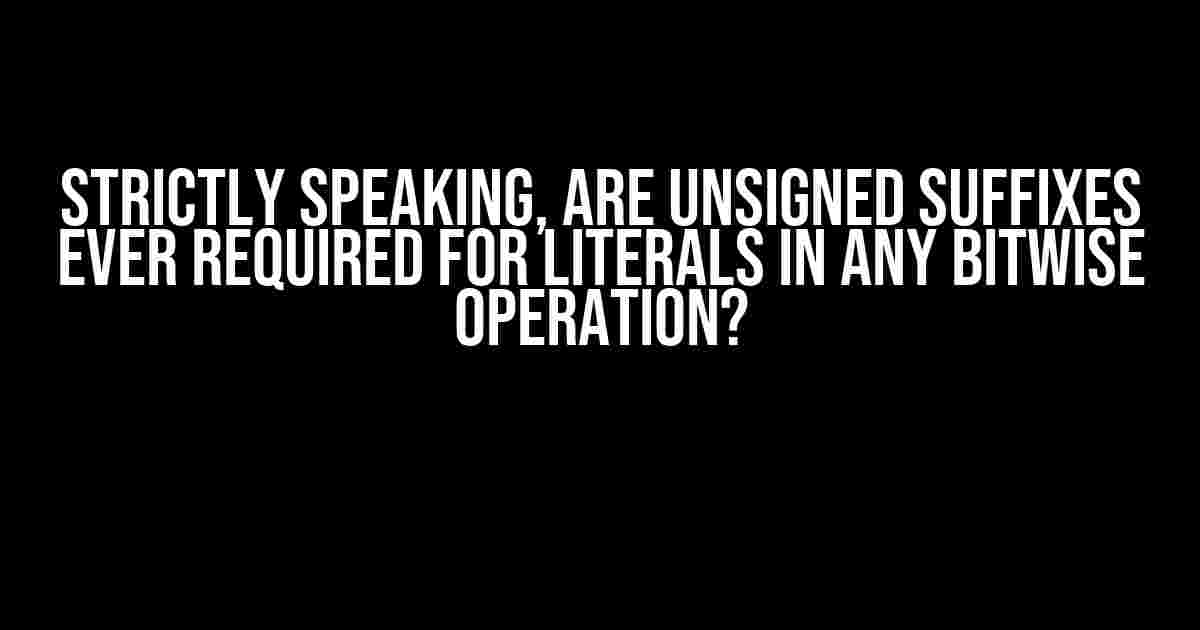If you’re a programmer, you’ve likely stumbled upon the concept of bitwise operations and suffixes. But have you ever wondered if unsigned suffixes are truly necessary for literals in these operations? In this article, we’ll delve into the world of bitwise operations, explore the role of suffixes, and provide a definitive answer to this question.
Bitwise Operations: A Quick Refresher
Bitwise operations are a fundamental concept in programming, allowing you to manipulate individual bits within a binary number. There are several types of bitwise operations, including:
- Bitwise AND (&): Performs a logical AND operation on two binary numbers, resulting in a new binary number.
- Bitwise OR (|): Performs a logical OR operation on two binary numbers, resulting in a new binary number.
- Bitwise XOR (^): Performs a logical XOR operation on two binary numbers, resulting in a new binary number.
- Bitwise NOT (~): Inverts all the bits of a binary number.
In C and C-derived languages, bitwise operations are performed using the corresponding operators (&, |, ^, and ~).
Suffixes: The Unsung Heroes of Literals
Suffixes are a crucial aspect of literals in programming, as they determine the type and size of the literal. In the context of bitwise operations, suffixes can significantly impact the outcome. There are two primary types of suffixes:
- Integer suffixes: u (unsigned), l (long), ul (unsigned long), ll (long long), and ull (unsigned long long)
- Floating-point suffixes: f (float), F (float), l (long double), and L (long double)
In this article, we’ll focus on integer suffixes, particularly the unsigned suffixes (u, ul, ll, and ull).
The short answer is: it depends on the operation and the language. In C and C-derived languages, unsigned suffixes are not always required for literals in bitwise operations. However, there are scenarios where they are essential to ensure correct results.
Scenario 1: Bitwise Operations with Signed Literals
Consider the following example:
int x = 0x80000000; // 0b1000000000000000000000000000000 int y = x & 0xFF; // 0b00000000000000000000000011111111
In this scenario, the bitwise AND operation is performed between a signed literal (0x80000000) and an unsigned literal (0xFF). Without an unsigned suffix, the result would be a signed integer, potentially leading to unexpected behavior.
Scenario 2: Bitwise Operations with Unsigned Literals
Now, consider this example:
unsigned int x = 0x80000000; // 0b1000000000000000000000000000000 unsigned int y = x & 0xFFu; // 0b00000000000000000000000011111111
In this case, the unsigned suffix (u) is not strictly necessary, as the operation is performed between two unsigned integers. However, including the suffix ensures that the result is explicitly unsigned, avoiding any potential issues.
Scenario 3: Bitwise Operations with Literals of Different Sizes
Suppose we have a scenario where we need to perform a bitwise operation between a 32-bit integer and a 64-bit integer:
uint32_t x = 0xFFFFFFFF; // 0b11111111111111111111111111111111 uint64_t y = x & 0xFFFFFFFFFFFFFFFFull; // 0b11111111111111111111111111111111
In this example, the unsigned suffix (ull) is crucial to ensure that the 64-bit literal is correctly interpreted. Without the suffix, the operation would be performed using a 32-bit integer, leading to incorrect results.
Best Practices for Using Unsigned Suffixes
While unsigned suffixes may not always be required, it’s essential to follow best practices to ensure clarity and correctness in your code:
- Use unsigned suffixes consistently, even when they’re not strictly necessary, to avoid ambiguity and ensure explicit typing.
- Specify the correct suffix for the size and type of the literal, especially when working with literals of different sizes.
- Avoid using signed literals in bitwise operations, as they can lead to unexpected behavior.
Conclusion
In conclusion, while unsigned suffixes may not always be required for literals in bitwise operations, they play a vital role in ensuring correct results and clarity in your code. By understanding the scenarios where unsigned suffixes are essential and following best practices, you can write more efficient, reliable, and maintainable code.
| Scenario | Unsigned Suffix Required? |
|---|---|
| Bitwise operations with signed literals | Yes |
| Bitwise operations with unsigned literals | No, but recommended for clarity |
| Bitwise operations with literals of different sizes | Yes |
Remember, in the world of bitwise operations, a little suffix can go a long way in ensuring the correctness and reliability of your code.
Frequently Asked Question
Get the lowdown on unsigned suffixes in bitwise operations – when are they really necessary?
Are unsigned suffixes required for integer literals in bitwise operations?
Strictly speaking, no, unsigned suffixes are not required for integer literals in bitwise operations. However, they can be useful in certain situations to avoid unexpected behavior due to sign extension.
What happens if I don’t use an unsigned suffix for a hexadecimal literal in a bitwise operation?
If you don’t use an unsigned suffix for a hexadecimal literal, the literal will be interpreted as a signed integer, and sign extension may occur, leading to unexpected results.
Are there any bitwise operations where unsigned suffixes are always required?
No, there aren’t any bitwise operations where unsigned suffixes are always required. However, using unsigned suffixes can help avoid unexpected behavior and make the code more readable and maintainable.
Can I use unsigned suffixes with decimal literals in bitwise operations?
Yes, you can use unsigned suffixes with decimal literals in bitwise operations. In fact, it’s a good practice to use unsigned suffixes with decimal literals to avoid any potential sign extension issues.
What’s the best practice for using unsigned suffixes in bitwise operations?
The best practice is to always use unsigned suffixes (such as U or u) with integer literals in bitwise operations to ensure that the literals are interpreted as unsigned integers, avoiding any potential sign extension issues.
